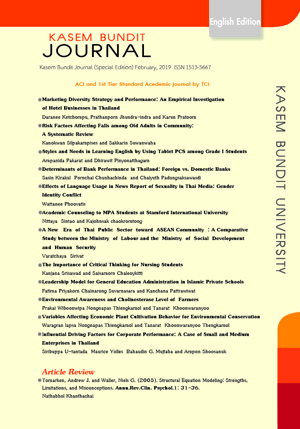Environmental Awareness and Cholinesterase Level of Farmers
Keywords:
Rice,, model, environmental awareness factors, cholinesterase level, agriculturalistAbstract
The purpose of this research was to develop model of environmental awareness factors affecting cholinesterase level of agriculturist in Yasothon Province by a survey research and the questionnaire used for data collection from the population of agriculturists in year of 2014. Multi-stage random sampling was employed for sampling sample group of 389 agriculturists from population of 70,546 agriculturist. Structural Equation model (SEM) was used for model verification covering knowledge of pesticide use, knowledge of primary health care, psychological trait, psychological state, environmental education, inspiration of public mind for environmental conservation, and environmental conservation behavior. Research results illustrated that the psychological trait (PST), psychological state (PsS), inspiration of public mind for environmental conservation (INS), environmental education (EE), environmental conservation behavior (BEH), knowledge of primary health care (HK), and knowledge of pesticide use (Kno) affected on cholinesterase level with value of 0.95, 0.92, , 0.88, 0.87, 0.81, 0.77, and 0.76 respectively.
References
Bureau of Occupational and Environmental Diseases. (2010). Manual of Safe from Disease of Agriculturist for Agriculturist and Public Health Volunteer. Bangkok: Agricultural Cooperative Community Publishing.
Chomputawat, S., Thiengkamol, N., Thiengkamol Khoowaranyoo, T. (2013b). Causal Relationship Model of Environmental Conservation Involved Psychological Factors for Agriculturist. European Journal of Scientific Research, 115 (1):147-165.
Charoensong, P., Artsanaratnajinda, P, Rittem, M., Chainarong, B, & Kamking S. (2011). Obsolete Pesticides. Bangkok: Office of Waste and Hazardous Waste Disposal. Department of Pollution Control. Ministry of Environment and Natural Resources. Thailand.
Department of Health. (1997). Guideline for Chemical Specimen Collection for Analysis of Occupational Health and Occupational Medicine. Nonthaburi: Department of Health.
Donkonchum, S. and Thiengkamol, N. (2012). Model of Environmental Education and Psychological State Affecting to Global Warming Alleviation. International Proceedings of Economic Development and Research, 44, 1-5.
Food and Drug Administration. (1997). Summary results of Project of Health Risk Evaluation of Pesticide Use of Agriculturist. Bangkok: War Veterans Organization of Thailand
Gonggool, D., Thiengkamol, N., & Thiengkamol, C. (2012b). Development of Environmental Education Volunteer Model through Inspiration of Public Consciousness for Sustainable Development. European Journal of Social Sciences, 32 (1):303-310.
Harrington, M.J. (2002). Pesticide exposure monitoring. Agrochem Environ News, 194:1–6
Issa, Y., Sham'a F.A., Nijem, K, Bjertness, E, & Kristensen, P. (2010). Pesticide use and opportunities of exposure among farmers and their families: cross-sectional studies 1998-2006 from Hebron governorate, occupied Palestinian territory. Environ Health. 2010 Oct 19; 9: 63. doi: 10.1186/1476-069X-9-63.
Katzung, B.G. (2001). Basic and clinical pharmacology: Introduction to autonomic Pharmacology.(8 ed.). The McGraw Hill Companies. pp. 75–91.
Koonboonchan, A., Thiengkamol, N., Thiengkamol Khoowaranyool, T. (2013b). Causal Relationship Model of Four Noble Truths Integrated with Psychological Factors. European Journal of Scientific Research, 115 (1):183-198.
Kotchakote, Y., Thiengkamol, N., Thiengkamol Khoowaranyoo, T. (2013b). Casual Relationship Model of Forest Fire Prevention Integrated with Psychological Factors. European Journal of Scientific Research, 104 (3):533-548.
Mongkonsin, Thiengkamol, N., & Thiengkamol, T. (2013b). Causal Relationship Model of Flood Response Behavior. Mediterranean Journal of Social Sciences, 4 (1):587-598.
Morrasri, P., Thiengkamol, N., & Thiengkamol, T. (2012b). Causal Relationship Model of Little Green Child with Environmental Behavior. European Journal of Social Sciences, 34 (2):177-189.
Phinnarach, K., Thiengkamol, N., & Thiengkamol, C. (2012a). Causal Relationship Model of Community Strength. European Journal of Social Sciences, 34 (3):379-392.
Pohanka (2011). “Cholinesterases, a target of pharmacology and toxicology”. Biomedical Papers Olomouc, 155 (3): 219–229.
Ramathibodi Poison Center. (2012). Statistic of State of Poison Received in Thailand. Retrieved from: https://www.ra.mahidol.ac.th/poisoncenter/
Saisunantharom, S. Thiengkamol, N., Thiengkamol, C. (2013b). Casual Relationship Model of Biodiversity Conservation Integrated with Psychological Factors. European Journal of Scientific Research, 115 (1):166-182.
Siripanich, S., Sayompurujinant, S, & Muanepueng, P. (2011). Surveillance System of Disease from Occupation and Environment with Passive type. Weekly Report of Epidemiology Division of Epidemiology, Department of Disease Control, Ministry of Public Health.
The Agricultural Bureau. (2010). Summary Report of Dangerous Object Import. Department of Agriculture, Ministry of Agricultural and Cooperatives. (2010).
Thiengkamol, N. (2009c). Environment and Development Book 2 (Food Security). Bangkok: Chulalongkorn University Press.
----------, N. (2011e). Environment and Development Book. (4th ed.). Bangkok: Chulalongkorn University Press.
----------. N. (2011i). Development of Model of Environmental Education and Inspiration of Public Consciousness Influencing to Global Warming Alleviation. European Journal of Social Sciences, 25 (4):506-514.
----------. N. (2011j). Model of Psychological State Affecting to Global Warming Alleviation. Canadian Social Science, 7 (6):89-95, December 31, 2011
----------. N (2012d). Model of Psychological Factors Affecting to Global Warming Alleviation. International Proceedings of Economic Development and Research, 44, 6-12.
----------. N. (2012e). Causal Relationship Model of Environmental Education.
Mediterranean Journal of Social Sciences, 3 (11), 11-18.
----------. N. (2012f). Causal Relationship Model of Environmental Educationand Psychological Trait. Mediterranean Journal of Social Sciences, 3 (11), 263-272.
----------. N N. (2012h). Model of Environmental Education and Psychological Factors Based on Inspiration of Public Consciousness Affecting to Global Warming Alleviation. Mediterranean Journal of Social Sciences, 3 (11), 435-444
Tougu, V. (2001). “Acetylcholinesterase: Mechanism of Catalysis and Inhibition”. Current Medicinal Chemistry Central Nervous System Agents, 1 (2): 155–170.
Tripathi, A. (2008). “Acetylcholinsterase: A Versatile Enzyme of Nervous System”. Annals of Neuroscience, 15 (4).
Tungkijthavorn, O. (2006). Prevention and Control the Danger from Chemical Substance. Journal of Health Promotion and Environmental Sanitation, 29 (1), January-March 2006.
Udonboon, C., Thiengkamol, N., & Thiengkamol, C. (2012b). Causal Relationship Model of Water Conservation Behavior. Mediterranean Journal of Social Sciences, 3 (11) : 599-611.
UNESCO. (1978). Intergovernmental Conference on Environmental Education Organized by UNESCO in Cooperation with UNEP Tbilisi (USSR) 14-16 October1977. Final Reports. Paris: UNESCO.
U.S. Environmental Protection Agency. (2013). What is a pesticide? Retrieved from: https://www.epa.gov/pesticides/about/index.htm. On 21/04/2013.
World Health Organization (WHO). (2006). Pesticides. Children's Health and the Environment, WHO Training Package for the Health Sector, World Health Organization.
Downloads
Published
How to Cite
Issue
Section
License
ทัศนคติ ความคิดเห็นใด ๆ ที่ปรากฏในวารสารเกษมบัณฑิตฉบับนี้เป็นของผู้เขียน โดยเฉพาะ มหาวิทยาลัยเกษมบัณฑิตและบรรณาธิการ ไม่จำเป็นต้องมีความเห็นพ้องด้วย







